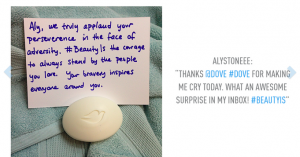Stories by far attract the most attention from consumers today — stories they can relate to, stories that entertain, and stories that inform.
It’s no wonder then that sales and marketing professionals are taking notice and incorporating the story format into their strategies.
Yet we’re not just talking about storytelling, which you’re already familiar with.
No, today’s sales and marketing teams are turning to the concept of storyselling, and it’s making big waves as a way to increase brand awareness and connect with customers.
Stories stick with you and will also stick with customers and potential customers if you present them in the right way for maximum impact.
By adding storyselling to your content marketing strategy, you can focus on providing meaningful stories around your products or services, reach a wider audience, and, in turn, increase your profits.
Here is everything you will learn today:
- What Exactly is Storyselling?
- Storytelling vs Storyselling
- What are the Benefits of Storyselling?
- The Elements of a Good Story
- Tips for Effective Storyselling
- Wrap Up
What Exactly is Storyselling?
Storyselling is a remarkable tool marketers can use to reach more customers and make their brand stand out.
Essentially, this technique combines the best elements of storytelling with the process of selling.
This combination can boost the positive perception of your brand and lead to a higher conversion rate.
Through storyselling, you can help your audience see your service or product in a new light and gain their attention more than if you use other types of marketing.
The goal is to attract and connect with your targeted audience in a way that makes you memorable and provides them with perceived benefits of purchasing what you have to offer.
More precisely, storyselling is a type of sales and digital marketing strategy utilizing stories instead of data about a service or product’s features or stats in order to make a sale.
Storyselling is also a method of selling without using a straightforward sales pitch or advertising.
Storytelling vs Storyselling
Storytelling revolves around the relaying of tales or stories of experiences, with no end goal in mind other than to share the story itself.
Storyselling, on the other hand, is a strategy to parlay information about a brand, product, or service in the form of a story and end with a call-to-action (CTA).
By weaving stories around your particular brand that your audience can identify with, you are reaching out to their emotions, attempting to build their trust and elicit a positive response.
Consumers are known to make purchases or choose a certain brand with the help of their emotions, so storyselling seeks to get to the heart of their emotions and show why the product or service is perfect for them.
What are the Benefits of Storyselling?
There are several benefits of storyselling, including the following.
Explains your Brand and its Purpose in a New Way
Storyselling can present your brand and explain its purpose without relying on sales pitch techniques, which consumers can see right through these days.
Instead, consumers experience your brand for the first time or the one-hundredth time in a meaningful way that showcases your brand’s values.
Attracts More Consumers
Consumers no longer like to be sold to and can tell whenever this occurs.
Today they want an experience that they can relate to, a brand they can trust to provide them with what they want or need.
Storyselling can do all of that and attract more consumers to turn into customers.
Provides a better way to sell particular types of products or services
Some products and services simply do not lend themselves to creative marketing techniques. Some are hard to sell or rely on design specifications or features to make them valuable to certain customers.
If your product or service contains complex features or doesn’t stand out visually, you can explain its usefulness to consumers by presenting it in a story.
If you make the story appealing and intriguing enough, consumers will want to learn more about those specifications and details.
Uses Inspiration to Ensure Sales
Stories can inspire people, and with well-designed storyselling, you can close sales in less time.
This is because the consumer will now relate your product or service with the stories you tell, and when they reach the end, they will feel inspired to continue the journey with you by purchasing what your brand has to offer.
Lets You Stand Out from Your Competition
A way to build authority and trust, storyselling can build stronger connections with your audience and current and future customers as opposed to those competitors still relying on traditional sales methods.
Making your story informative and relevant to customers helps them to remember it and your brand, and they will look to you instead of your competition.
Can Result in Returning Customers
Storyselling can come in various forms and include anything from customer testimonials to a new add-on feature to an already popular product.
These will remind customers of your product and service value and lead them to become returning customers.
The Elements of a Good Story
Incorporating the elements of a good story into your storyselling marketing campaign will not only reach your targeted audience but also spark something in them that relates and inspires them to make a purchase.
While storyselling differs from writing stories simply for entertainment, there are three distinct shared elements.
What are these elements of a good story for a marketing campaign?
Characters
You want your audience to identify in some way to the characters involved in your story.
For storyselling, the character can be based on actual customers who have had real-life experience with your brand or can be a version of your well-researched buyer personas.
A Relatable Problem or Challenge
Once you have your real or fictional characters chosen, you need to present a problem or a challenge they face and make it relatable to your target audience.
What challenge is similar to that of your audience that you are targeting with this particular product or service?
A Successful Solution
Now that your audience is relating to your character and the problem or challenge at hand, offer a successful solution that involves your brand.
You know you’ve successfully added these elements when you can see results, such as:
- Your story and your brand are memorable.
- The story itself brings life to your brand, product, or service.
- It has provided you with a competitive advantage.
- You gain a broader target audience.
- It helps your brand, product, or service to stand out and differentiate what you offer.
- Builds trust and authority in your brand.
Tips for Effective Storyselling
The key to attracting more of your audience is in how you tell your story.
What can make your product or service more relevant and enticing? Start by avoiding content narrowly focused on a product’s features or stats.
Instead, highlight the product or service’s benefits. Show how customers can benefit from its usage.
For even more effective storyselling, consider the following tips.
1. Use a Provoking Hook to Reel in Your Audience
To catch the attention and eye of consumers, use a hook (title, tagline, etc.) that caters to their sense of curiosity.
Follow that hook with an opening that intrigues your audience, causing them to stay for the duration of the storyselling experience.
2. Go for Transparency to Garner Trust
While subtle sales pitches are often part of your storyselling, keep transparency at the top of your guidelines when creating the story to use.
You want it to sound honest, giving consumers the rightful impression that you are being open and real with them.
3. Make the Impersonal Personal
Whatever your product or service, make it personal by giving it meaning.
Find ways to connect with your audience, make your product or service relatable enough to trigger emotions, and make an impression regarding your brand.
4. Show How Your Audience Will Benefit
Create a story that helps your audience relate to your product or service, and create an understanding of what it is you offer and how it can help them in their own life.
A way to accomplish this is to include a before and after effect, showing how your brand can solve a challenge or problem your targeted audience experiences.
5. Use Empathy
Take an empathetic marketing approach and place yourself in your audience’s shoes. Translate that into a story that gets their attention and answers their needs more succinctly.
6. Add a Feel-Good Ending
How you wrap up your story is pivotal to the responses you get from your audience. Show relief or a happy ending, so consumers feel good about your brand and what it can do for them.
Wrap Up
Finding new ways to utilize stories in your sales and marketing strategy will lead to higher brand awareness and a way to connect with more of your targeted audience in a genuine way.
As a result, you’ll watch your profits rise.
Storyselling goes beyond just telling a story. It tells the story in such a way the readers will want to continue knowing your brand and what you can do for them.
To find out more on how your content can help the selling process, check out this recorded webinar with best-selling author Aaron Ross.









